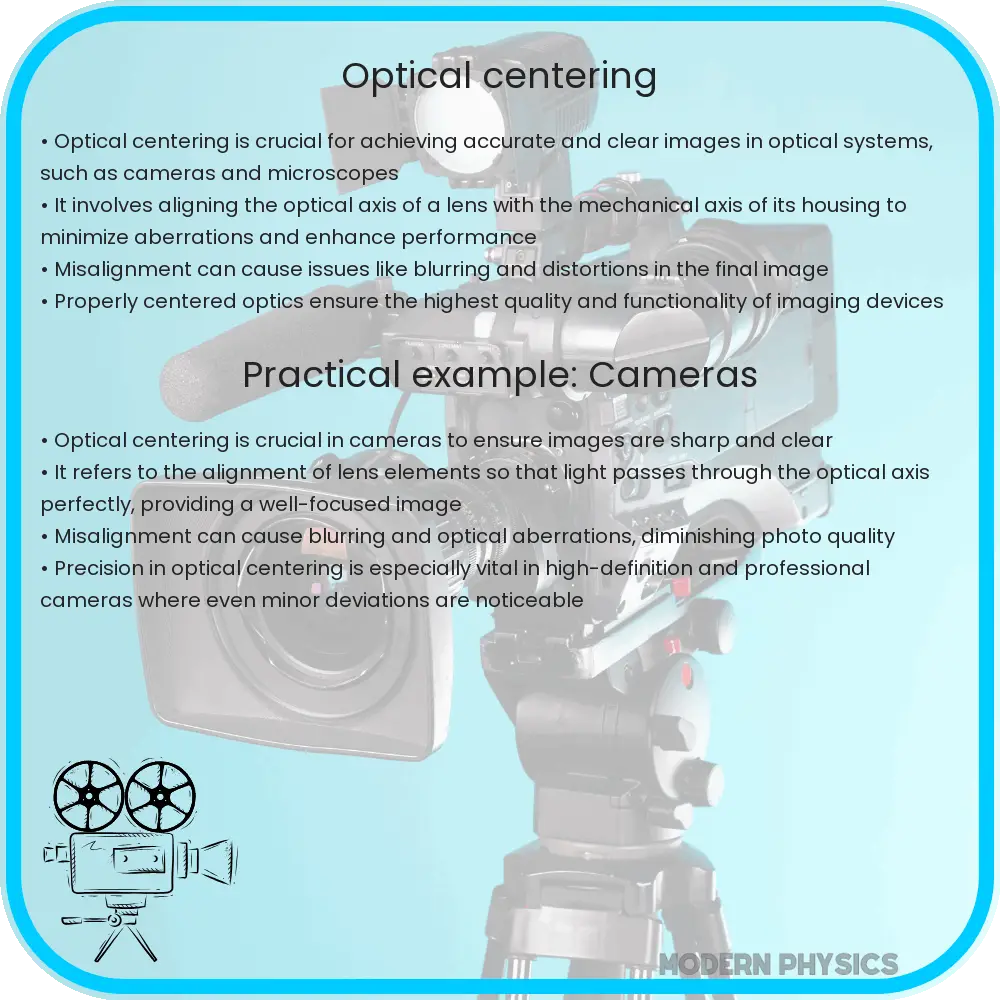Explore the essentials of optical centering in geometrical optics, its impact on precision and efficiency, and the latest technological advancements.

Understanding Optical Centering in Geometrical Optics
Optical centering is a crucial concept in geometrical optics, fundamental for ensuring precision and alignment in optical systems. This process involves correctly positioning optical elements, like lenses and mirrors, in an optical system to achieve optimal performance. The significance of optical centering lies in its impact on the efficiency and accuracy of optical devices, ranging from simple magnifying glasses to complex telescopes and cameras.
Principles of Optical Centering
The main principle behind optical centering is the alignment of the optical axis. The optical axis is an imaginary line that runs through the center of the lens or mirror and is perpendicular to the surface. For an optical system to function correctly, all optical elements must be aligned along this axis. Misalignment can lead to various issues such as astigmatism, coma, and spherical aberration, significantly degrading the quality of the image produced.
Techniques for Optical Centering
Several techniques are employed to achieve precise optical centering. One common method is using a collimator, which produces a parallel beam of light. When this beam passes through the optical system, any deviation from the center can be detected and corrected. Another technique involves the use of autocollimators, which are highly sensitive and used for fine adjustments.
Importance of Precision in Optical Centering
Precision in optical centering is not just about aligning optical elements; it’s also about maintaining the correct distance between them. This spacing is crucial, especially in systems like compound microscopes or telescopes, where multiple lenses are used. Incorrect spacing can result in chromatic aberration, where different wavelengths of light are focused at different distances, causing a blurred or colored fringe around the image.
Alignment Challenges and Solutions
Aligning optical elements can be challenging, particularly in complex systems with multiple components. To address these challenges, advanced techniques like laser alignment and computer-aided design (CAD) are employed. These methods provide higher accuracy and are essential in applications like laser systems and astronomical telescopes, where even minute misalignments can lead to significant errors.
Efficiency in optical systems is directly tied to the precision of optical centering. A well-centered optical system not only produces clearer images but also operates more efficiently, with less light loss and better overall performance. This efficiency is particularly important in scientific research and industrial applications, where the accuracy of optical measurements can be critical.
In conclusion, optical centering is a vital aspect of geometrical optics, impacting the performance and efficiency of optical systems. Through precise alignment and spacing of optical elements, optical centering ensures the delivery of clear, accurate images and the optimal functioning of optical devices.
Advanced Applications and Innovations in Optical Centering
Optical centering extends beyond conventional optical devices to advanced scientific and industrial applications. In fields like astronomy, medical imaging, and semiconductor manufacturing, the demand for ultra-precise optical systems is continuously growing. Innovations in optical centering techniques, such as adaptive optics, play a significant role in meeting these demands. Adaptive optics, for example, involves dynamically adjusting the shape of mirrors to counteract atmospheric distortion, a technique crucial in large telescopes.
Impact of Technological Advancements
Technological advancements have significantly enhanced the capabilities of optical centering. The integration of computer-controlled alignment systems, for instance, allows for automated and highly precise adjustments. These systems are particularly beneficial in the production and maintenance of complex optical instruments where manual alignment would be impractical or impossible.
Challenges in Miniaturization and Integration
As optical technology progresses towards miniaturization and integration, new challenges in optical centering emerge. In devices like micro-opto-electro-mechanical systems (MOEMS), the alignment has to be accurate at the micrometer or even nanometer scale. This level of precision requires innovative techniques and equipment, including advanced microscopy and nanotechnology tools.
Future Trends and Research
Future trends in optical centering point towards further integration with digital technologies and artificial intelligence (AI). AI algorithms can be used to predict and correct alignment issues in real-time, enhancing the efficiency and performance of optical systems. Ongoing research in materials science and nanotechnology is also expected to introduce new materials and methods that could revolutionize optical centering techniques.
Conclusion
In summary, optical centering is a cornerstone of geometrical optics, essential for the precision, alignment, and efficiency of optical systems. From the simple alignment of a camera lens to the complex calibration of telescopes and laser systems, the principles of optical centering are universally applied. The continual evolution of this field, driven by technological advancements and research, promises to overcome current limitations and open up new possibilities in optics. As we move forward, the importance of precise optical centering in enhancing the performance of optical systems and supporting cutting-edge applications in science and industry cannot be overstated. With each advancement, we step closer to a future where the full potential of optical technologies is realized, contributing significantly to scientific discovery and technological innovation.
